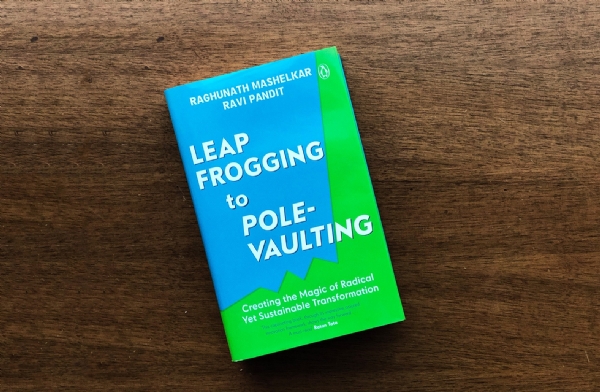Book Review: "Leapfrogging to Pole Vaulting", Creating the Magic of Radical Yet Sustainable Transformation
"Leapfrogging to Pole Vaulting" goes beyond economic growth to explore the social and environmental implications of leapfrogging.
Total Views |
"Leapfrogging to Pole Vaulting" is an inspiring and insightful book that explores the concept of leapfrogging in the context of innovation and economic growth. Authored by Raghunath Mashelkar and Ravi Pandit, this book presents a compelling argument for how developing nations can overcome challenges and achieve rapid progress by leapfrogging traditional stages of development.

The book explores the potential for India to make significant advancements by skipping intermediate steps in development, a concept known as "leapfrogging." The authors extend this idea to "pole vaulting," suggesting that India can achieve even greater heights by adopting innovative strategies and technologies.
The Authors
Raghunath Mashelkar

Raghunath Mashelkar, is a renowned Indian scientist known for his pioneering contributions in the field of chemical engineering and science policy. He has made significant impacts in various domains, including scientific research, innovation, and policy advocacy.
Mashelkar has held several prestigious positions, including the Director-General of the Council of Scientific and Industrial Research (CSIR), one of the world's largest publicly funded R&D organizations.
His contributions have been acknowledged globally, with numerous awards and honors, including the Padma Vibhushan, Padma Bhushan, and Padma Shri from the Government of India. He is a Fellow of the Royal Society (FRS) and has received honorary doctorates from several universities.
Ravi Pandit

Ravi Pandit is a prominent entrepreneur and business leader, best known as the co-founder and Chairman of KPIT Technologies, a global IT consulting and product engineering organization.
Pandit's contributions to business and technology have been widely recognized. He has received several awards for entrepreneurship and innovation, including the prestigious Ernst & Young Entrepreneur of the Year Award.
Embracing Radical Transformation
"Creating the Magic of Radical Yet Sustainable Transformation" is a compelling call to move beyond incremental progress and embrace radical change. The book offers a visionary approach to solving complex problems through innovative solutions, urging readers to think beyond traditional methods.
The '3-4-7 Framework'
Central to the book is the ‘3-4-7 framework,’ a methodical approach that breaks down seemingly insurmountable challenges into manageable components, making every problem solvable. This framework is particularly relevant in today’s fast-paced world, where conventional problem-solving methods often fall short.
A Practical Guide for Action
The book is not merely an academic treatise but a practical guide that inspires action. Written with a sense of urgency, it advocates for proactive pole-vaulting over reactive leapfrogging. The engaging narrative, filled with anecdotes and examples, resonates with policymakers, entrepreneurs, and a wide range of readers.
A Manifesto for the Future
At its core, “Leapfrogging to Pole-Vaulting” is an exhilarating manifesto for the future. It advocates for radical transformation that is both innovative and sustainable. This book is a valuable resource for anyone looking to make a significant impact in their field or society at large.
Setting the Stage
Mashelkar and Pandit outlinine the historical context of leapfrogging, explaining how countries like India and China have bypassed conventional development stages to catch up rapidly with developed nations. They delve into the factors that contribute to successful leapfrogging, including technological advancements, policy reforms, and entrepreneurial spirit.
Clear and Accessible Ideas
One of the book's strengths is its clear presentation of complex ideas. The authors use real-world examples and case studies to illustrate their points effectively. From India's IT revolution to China's manufacturing prowess, the book showcases how leapfrogging has propelled nations to the forefront of global competition.
Beyond Economics
"Leapfrogging to Pole Vaulting" goes beyond economic growth to explore the social and environmental implications of leapfrogging. The authors emphasize the importance of sustainable development and inclusive growth, arguing that leapfrogging can be a catalyst for positive change in these areas, benefiting individual nations and contributing to global progress.
Actionable Insights
Throughout the book, authors provide actionable insights for policymakers, entrepreneurs, and innovators. They discuss the role of education, research and development, intellectual property rights, and collaboration between industry and academia. The authors also address the challenges and obstacles to leapfrogging, offering strategies to overcome them.
A Broad Perspective
While the book primarily focuses on India, the concepts and principles discussed are applicable to any country striving for rapid development. The authors' perspectives are enriched by their deep understanding of innovation and entrepreneurship, making the book relevant globally.
Technical Depth
If there is a minor drawback, it is that the book occasionally becomes overly technical, especially when discussing specific technologies or policy frameworks. However, the authors' passion and expertise shine through, making the book engaging and informative overall.
"Leapfrogging to Pole Vaulting" dives into various aspects of leapfrogging, providing a comprehensive examination of the concept and its implications. Here are some important details about the book:
Leapfrogging Strategies: The authors explore different strategies that can facilitate leapfrogging. They delve into the importance of investing in research and development, promoting indigenous innovation, and leveraging emerging technologies such as artificial intelligence, robotics, and renewable energy. By adopting these strategies, developing nations can overcome resource constraints and achieve rapid progress.
Policy Reforms: The book emphasizes the role of policy reforms in enabling leapfrogging. Mashelkar and Pandit discuss the need for governments to create a conducive environment for innovation by implementing favourable policies, reducing bureaucratic hurdles, and fostering collaboration between the public and private sectors. They also address the significance of intellectual property rights and the need to strike a balance between protection and access to knowledge.
Education and Skill Development: The authors highlight the importance of education and skill development in fostering leapfrogging. They examine the role of educational institutions in nurturing an entrepreneurial mindset and equipping individuals with the necessary skills to drive innovation. The book also explores the concept of lifelong learning and the need for continuous upskilling in a rapidly changing world.
Social and Environmental Impact: "Leapfrogging to Pole Vaulting" goes beyond economic growth and emphasizes the importance of social and environmental sustainability. The authors discuss how leapfrogging can lead to inclusive growth by creating opportunities for marginalized communities and reducing income disparities. They also address environmental challenges and the need for sustainable practices to mitigate the negative impact of rapid development.
Global Perspectives: While the focus of the book is primarily on India and China, the authors draw insights from other countries as well. They examine success stories from countries like South Korea, Brazil, and Kenya, showcasing how leapfrogging has played a crucial role in their development journeys. This global perspective provides a broader understanding of the concept and its applicability across different regions.
Case Studies and Practical Examples: Throughout the book, Mashelkar and Pandit present numerous case studies and practical examples to support their arguments. These examples range from breakthrough innovations in healthcare and agriculture to successful entrepreneurial ventures. By showcasing real-world experiences, the authors illustrate how leapfrogging has transformed various sectors and industries.
Technological Leapfrogging: The book extensively explores the role of technology in leapfrogging. It examines how developing nations can leverage advancements in information and communication technology (ICT) to overcome infrastructure gaps and accelerate progress. The authors discuss the transformative power of mobile phones, internet connectivity, and digital platforms in areas such as financial inclusion, e-commerce, and access to education and healthcare.
Innovation Ecosystem: Mashelkar and Pandit delve into the importance of building a robust innovation ecosystem to support leapfrogging. They discuss the need for collaboration between academia, industry, and government to foster innovation, entrepreneurship, and knowledge sharing. The authors also emphasize the significance of creating incubators, accelerators, and funding mechanisms to nurture and scale innovative ideas.
Impact on Employment: The book addresses the potential impact of leapfrogging on employment patterns. It explores how technological advancements and automation can create both opportunities and challenges in the job market. The authors highlight the need for reskilling and upskilling the workforce to adapt to changing skill requirements and ensure inclusive growth.
Lessons from Failure: While showcasing success stories, the authors also acknowledge the importance of learning from failures and setbacks. They discuss instances where leapfrogging attempts fell short and analyze the underlying reasons. By examining these failures, the book provides valuable insights on how to navigate obstacles and mitigate risks in the pursuit of leapfrogging.
Ethical Considerations: In addition to economic and social aspects, the authors touch upon ethical considerations associated with leapfrogging. They discuss the importance of responsible innovation, ethical use of technology, and addressing potential risks such as privacy concerns and cybersecurity threats. The book encourages a balanced approach that takes into account the ethical implications of leapfrogging advancements.
Roadmap for Leapfrogging: Towards the end of the book, Mashelkar and Pandit provide a roadmap for countries aspiring to leapfrog. They outline key steps and strategies, along with practical recommendations, to create an enabling environment for leapfrogging. The roadmap covers areas such as policy reforms, investment in research and development, fostering innovation culture, and building strong partnerships.
"Leapfrogging to Pole Vaulting" is a comprehensive guide that combines theoretical frameworks, practical examples, and actionable insights. It presents a holistic view of leapfrogging as a catalyst for economic and social transformation. The book's multidimensional approach allows readers to understand the complexities involved in leapfrogging and provides guidance for individuals, organizations, and policymakers aiming to embrace this concept.
By highlighting the potential of leapfrogging, the authors inspire readers to think innovatively, challenge existing paradigms, and drive positive change. Whether you are interested in economics, technology, social development, or entrepreneurship, this book offers a wealth of knowledge and ideas to explore.
"Leapfrogging to Pole Vaulting" offers a comprehensive exploration of leapfrogging as a powerful tool for economic growth and development.
Author's Conclusion

"Leapfrogging to Pole Vaulting" is a thought-provoking and informative book that explores the concept of leapfrogging and its potential to accelerate progress in developing nations. Raghunath Mashelkar and Ravi Pandit provide a compelling argument for embracing leapfrogging and offer practical guidance for those seeking to foster innovation and economic growth. This book is a must-read for policymakers, entrepreneurs, and anyone interested in understanding the dynamics of leapfrogging in the global economy.
The book presents a compelling argument for India to adopt an ambitious and innovative approach to its development. By leveraging new technologies, fostering a culture of innovation, and implementing forward-thinking policies, India has the potential to not only catch up with but also surpass other nations in terms of economic and social development. The book serves as a roadmap for policymakers, entrepreneurs, and citizens to envision and work towards a transformative future.
--


